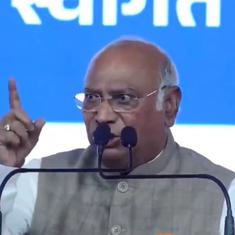In a rundown government school in Drehgam, a village in central Kashmir’s Budgam district, class was in session on Monday. But the lesson being taught to Class 10 students was a departure from the set syllabus. “Digital transactions will not only make transactions easy, it will also end corruption,” said Shubeena Gul, the instructor. Stuck on the whiteboard were pieces of paper with the slogan “Go Cashless, Go Digital”.
Gul – one of three instructors training residents in the district to make digital payments as part of an initiative by the Common Services Centre e-Governance Services India Limited – went on to instruct the students on how to use PayTM.
A kilometre from Drehgam is Lanura, a sleepy village with few shops and a largely agrarian economy. Lanura was declared the first cashless village in Jammu and Kashmir on December 18. Here, 150 of the over 1,000 residents have been trained in conducting transactions digitally.
“We trained them in using PayTM, debit and credit cards,” said Mohammad Yasin Thoker, another instructor. “We want to make the villages [in the district] cashless… We have trained at least one in each household.” All of this, he added, was part of the plan to realise the idea of a Digital India.
But that’s easier said than done. In Lanura, where residents are only now filling up forms to obtain ATM cards, digital payments remain a distant dream. The absence of steady internet connections, few smartphone users, and a generation of older people hesitant to adapt to mobile phones makes cash the preferred mode of transaction, even as the village has been declared cashless.
Cashless, in name
The push for digital payments has gathered steam in the wake of the government’s demonetisation of high-value bank notes, which resulted in a massive cash crunch. But there are massive hurdles to this cashless drive.
In Kashmir, the instructors conducting workshops on digital payments admitted as much. Scrappy internet connectivity and the lack of point of sale devices in Lanura village stand in the way of it going truly digital, they said. The nearest ATM is 5 km away.
Thoker said most villagers want to continue with cash, but even “if someone wants to use credit or debit cards, there are no PoS devices while if someone wants to use PayTM, there might not be internet connectivity”. He also said that while the young were quick to pick up the idea of digital transactions, older residents were finding it difficult.
Accustomed to dealing in cash all their lives, most residents are nervous about going cashless, especially when they are still struggling to learn how to use mobile phones for basic functions. Arif Dar, a shopkeeper in his 50s, laughed at the idea of digital payments as he turned down Thoker’s invitation to a class in the building next to his store. “The day everyone starts using it, I will consider it,” he said.
Firdaus Ahmad, 30, runs a medical store in the village and has downloaded PayTM on his phone. Taking out his smartphone, he exchanged Rs 20 with Thoker via the eWallet. However, few residents have made any cashless business transaction so far, and Ahmad said he was still ignorant of how a point of sale device worked. “I transact largely in cash,” he said. “I have only done two or three digital transactions. So far, we have had to rely on cash as apart from our customers, distributors and suppliers too do not use any digital method.

Awareness is all it takes
Declaring a village cashless is based on awareness and not on the actual implementation of digital transactions, explained Mohsin Nazim, the Budgam district manager for Common Services Centre e-Governance. “All over India, there is no village that has become cashless,” he said. “It will take two-three years for practical implementation” of cashless payments.
The programme entails training at least one person from each household and 10 merchants per village. Nazim said that those who receive training are registered and monitored through the Common Services Centre portal. “We have a target of December 31 to train at least one person in each household,” he said. “We focus more on the merchants.”
The Common Service Centre is also in charge of facilitating the installation of point of service devices and other digital payment mechanisms.
Despite the hurdles, drug store owner Firdaus Ahmad was enthusiastic about going digital and said he hoped to procure a card device soon. “These days, there is a problem of change,” he said. “It (digital transaction) is hassle-free, safe, and will save time for everyone. Everyone wants to shift to it. It will take time but it will happen.”
In this spirit of optimism, the digital drive continues in the state. On December 21, another village, Manzigam in South Kashmir’s Anantnag district, was declared cashless.










